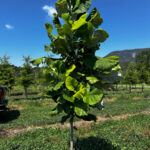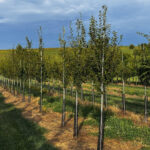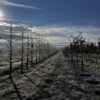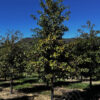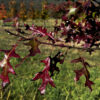The common pawpaw (Asimina triloba) is one of the more unique natives of eastern North America. Asimina is the only genus of the Annonaceæ, the custard-apple or soursop family, to grow outside of the tropics or neotropics. The Annonaceæ in general is a valued family of economically important plants, including the fruits soursop, sweetsop, and custard-apple as well as ylang-ylang, whose flower oils are a basis of many perfume oils. The common pawpaw’s native range extends from extreme southern Canada south to the Gulf Coast states and west to the edge of the tallgrass prairie. Its native habit is moist, acidic bottomlands or hollows, typically as an understory plant or at the margin of woodlands.
A. triloba is typically a small tree or single-stemmed shrub, usually topping out at 5-8 m (15-25 ft) in height, with a coarse, upright form. The large (15-30 cm; 6-12”), elliptical, slightly drooping leaves have a thin drip tip (uncommon outside of tropical rainforests) and are a medium to dark green and turn a rusty yellow later in autumn. The overall effect of the tree and leaf form lends a distinctly tropical appearance. The crushed leaves have a faint odor, similar to bell pepper (Caspicum annuum cvs.). The attractive flowers, 2-4 cm (⅔ to 1½ in) across, sport two layers of three dark reddish-purple recurving petals arranged in a triangular pattern and reside on short pedicels separate from the leaf buds. They typically appear in early April in Virginia, just ahead or concurrently with leaf bud break and have a faint rancid odor that attracts certain beetles and flies as pollinators. Although the flowers are perfect (male and female parts in the same flowers), the female and male stages of the flowers occur sequentially rendering the pawpaw only weakly self-fertile and requiring separate individuals for good fruit set. These edible mango-like fruits (technically a three-lobed berry) ripen in late summer and are 6-15 cm (2½-6 in) in length and half that in width. The fruit turns brown and falls from the tree when ripe; the ‘guts’ of the fruit are a pulpy mass with a banana-like flavor surrounding several hard brown seeds. The bark is typically a smooth light grey with prominent lenticles.
(article continues after photos)
In its native habitat, pawpaw often exhibits clonal behavior, much like quaking aspen (Populus tremuloides), forming thick stands of genetically identical trunks that feed from a common root system. This behavior does not commonly occur in the landscape where ideal conditions (well-drained, most, acidic soil) are not nearly as common as in the wild. Despite the edibility of the fruit, A. triloba—like almost all members of the Annonaceæ—contains an acetogenin neurotoxin in small amounts, which protects the plant leaves and unripe fruit from most insect and mammalian predators. It is only very rarely browsed by deer because of this. The neurotoxin within the fruit dissipates as it ripens but can cause mild gastric upset as well as contact dermatitis in some sensitive individuals.
In addition to the fruit, the stringy inner bark of pawpaw was also woven by native Americans for ropes and fishing line. The plant is virtually pest-free, aside from a borer that has adapted to its toxins and causes only minor damage. The foliage is a primary food source for pawpaw sphinx caterpillars (Dolba hyloeus) and the excusive host for the caterpillars of the zebra swallowtail (Protographium marcellus).
Pawpaw is a great native choice for a small specimen tree in the shrub border or as a wood-edge ornamental like eastern dogwood (Cornus florida). Because of its tendency to form colonies and deep taproots in favored sites, it is also highly useful for stabilizing erosion-prone streambanks. It prefers some shelter from strong winds and is generally salt-intolerant. For autumn 2025, WHN has Asiminia triloba available in 5 ft and 6 ft sizes along with a more limited availability of1-1½” caliper.


